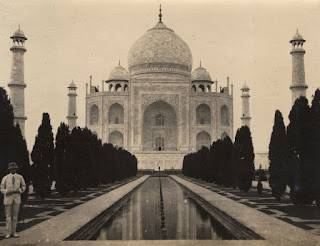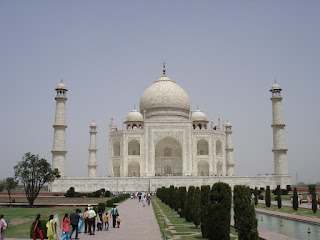 | The Taj Mahal. Date: 1924-03-07 (March 7, 1924) Creator: Sawyer, Wilbur A. Rights: This item is in the public domain. It may be used without permission. High Resolution Image. Image Credit: National Library of Medicine's Profiles in Science. Uneditted Image |
Description: The Sawyer family left Australia in January 1924, returning to New York via Ceylon, India, Egypt, and Europe. Dr. Sawyer, as the Rockefeller Foundation's assistant regional director for the East, spent the first part of the journey visiting RF hookworm control sites (and potential sites) in Ceylon and India, but combined this with sightseeing.
He spent April 7-8 touring the Taj Mahal and surrounding area. The caption on the back of the photograph reads, "Taj Mahal immediately after sunset. About 6:30pm. Apr 7, 1924. 110 screen. Time Exposure." The man at far left in photo is not identified.
High Resolution Image Image and text credit, Department of the Interior/USGS, U.S. Geological Survey/
SUSAN E. HOUGH, Scientist-in-Charge, Pasadena Office, U.S. Geological Survey, California
Copyrights and Trademarks: Most U.S. Geological Survey (USGS) information resides in the public domain and may be used without restriction. There is no legal requirement for users to acknowledge or credit USGS as the source for public domain information, but you may wish to do so as a courtesy. If you wish to acknowledge or credit USGS as an information source of data or products, use a line of text as shown in the guidance below.
Credit: U.S. Geological Survey, Department of the Interior/USGS, U.S. Geological Survey/photo by Jane Doe (if the photographer/artist is known), Optional Statement : The following statement may be added after an acknowledgment or credit: The USGS home page is usgs.gov .
Taj Mahal From Wikipedia, the free encyclopedia
The Taj Mahal (Devanagari: ताज महल, Nastaliq: تاج محل) is a mausoleum located in Agra, India. The Mughal Emperor Shah Jahan commissioned it as a mausoleum for his favorite wife, Mumtaz Mahal. Construction began in 1632 and was completed in approximately 1648. Some dispute surrounds the question of who designed the Taj Mahal; it is clear a team of designers and craftsmen were responsible for the design, with Ustad Ahmad Lahauri considered the most likely candidate as the principal designer.
The Taj Mahal (sometimes called "the Taj") is generally considered the finest example of Mughal architecture, a style that combines elements of Persian, Turkish, Indian, and Islamic architectural styles. While the white domed marble mausoleum is the most familiar part of the monument, the Taj Mahal is actually an integrated complex of structures. In 1983 the Taj became a UNESCO World Heritage Site and was cited as "the jewel of Muslim art in India and one of the universally admired masterpieces of the world's heritage.
This article is licensed under the GNU Free Documentation License. It uses material from the Wikipedia article, Taj Mahal
Technorati tags: Public Domain Clip Art and clip art or public domain and The Taj Mahal or Mughal Emperor Shah Jahan and Agra, India or Fred Thompson Republican Conference VIDEO and Althea Gibson and FSU researchers developing diagnostic 'lab on a chip'













No comments:
Post a Comment